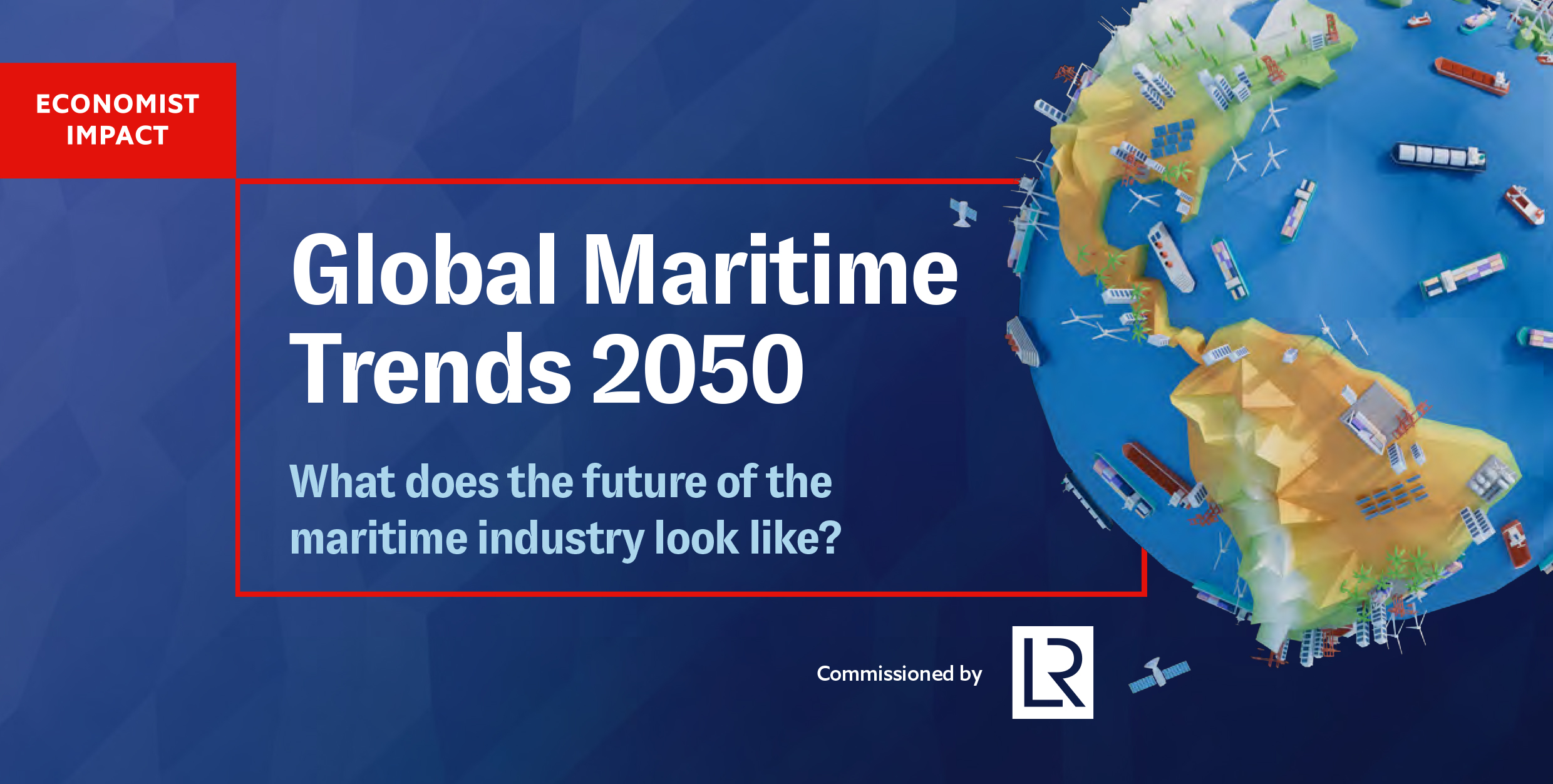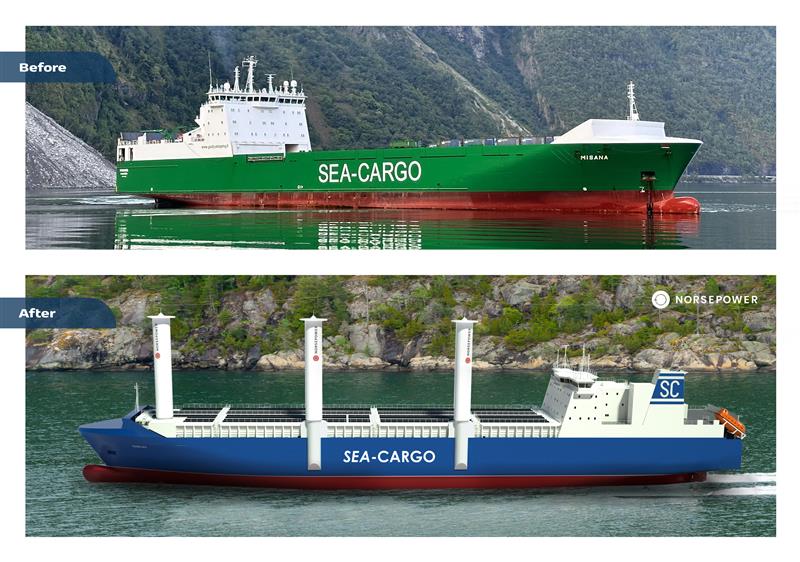Global Maritime Trends 2050 report
This autumn Lloyd’s Register and Lloyd’s Register Foundation launched the Global Maritime Trends 2050 report as part of a broader multi-year Global Maritime Trends 2050 Research Programme.
‘Global Maritime Trends 2050’ is a report that analyses likely future scenarios for shipping in 2050, based on the speed of technology adoption and the level of global collaboration, to help the industry forecast risks, opportunities, and required investment.
Authored by Economist Impact, the research involved an extensive literature review and 16 qualitative interviews with maritime policy and industry professionals.
This research led to four feasible shipping futures that present warnings and opportunities for our sector, including fictional 'what if' scenarios such as the opportunities widespread adoption of hydrogen could bring or the potential critical challenges posed by a 40cm sea-level rise.
Key takeaways:
-
Key global ports in US, Europe, and Asia could be unusable by 2050 without urgent action on decarbonisation
-
African countries could become the dominant supplier of seafarers by 2050
-
Women could make up 25% of all seafarers by 2050 (currently <2%)
The four ‘what if’ scenarios:
From the four future maritime landscapes, Economist Impact has created four 'what if' scenarios influenced by decisions on technology progression and global cooperation around climate change.
Scenario 1 – What if there is a gradual, just energy transition that sees wide adoption of green hydrogen by 2050?
In the first scenario, just gradual transition, nations embrace the widespread adoption of green hydrogen, transforming the shipping sector into a champion of decarbonisation. This scenario sees the likes of China, Saudi Arabia, South Africa, and the US emerge as leading green energy producers. Ammonia becomes the top choice for hydrogen transport, sparking job creation and skill development, and the target for women to make up a quarter of all seafarers by 2040 is met. This future hinges on global climate cooperation, political backing, swift adoption of fuel technologies, ports reimagined for new fuels, and an increased demand for tech-savvy ship managers.
Scenario 2 – What if automated technology solutions became widely adopted in the maritime sector by 2050?
Scenario 2, rapid tech-driven transition, imagines a future where automated technology solutions become widely adopted in the maritime sector. Ships and ports, supercharged by remote control, automation, and IoT, usher in a new era of maritime trade efficiency. Yet, in this high-tech age, skilled human oversight remains paramount, complemented by AI assistants and the likes of immersive metaverse tools. How do we achieve this vision? Robust tech investments across the industry, a united front on decarbonisation, globally synchronised tech protocols, and training that evolves with innovation.
Scenario 3 – What if regionalisation, amid population expansion, leads to de-globalisation and fragmented global maritime trade by 2050?
In scenario 3, regionalised and fragmented transition, we see a future dominated by regionalisation and population growth leading to de-globalisation and fragmented maritime trade. This could mean smaller ships navigating shorter routes while differing technological adoptions across regions could spike costs. The absence of a unified approach to governance and trade could give rise to 'dark fleets' operating covertly. This scenario is influenced by rising consumer demand in Asia and Africa, geopolitical shifts and supply chain challenges, a decline in collaborative innovation and decarbonisation efforts, and a mismatch in technology adoption, leading to port inconsistencies.
Scenario 4 – What if average global sea levels rose by at least 40cm by 2050?
In the fourth scenario, delayed transition, we see a world where average sea levels surge by at least 40cm, resulting in a seismic shift in shipping dynamics. As climate change intensifies, traditional shipping routes may face challenges, leading to augmented traffic in the unpredictable Arctic Ocean due to melting ice. Frequent extreme weather events and natural disasters will heighten insurance costs and demands, and many vital economic ports risk submersion. This scenario emerges from limited collaboration on climate action, staggered technology adoption, disrupted supply chains due to increasing soil and water salinity, and escalating coastal flooding due to rising sea levels.
Beyond the figures and forecasts, this report reinforces our industry's core principle: people matter.
We must continue to place the wellbeing of our two million seafarers at the heart of our strategies and actions. Their unwavering commitment has been the bedrock of our industry, and as we navigate the waters toward 2050, ensuring their safety, rights, and growth becomes non-negotiable.
This report – and the longer-term programme – are possible because of the unique relationship between Lloyd's Register – a leading maritime professional services company, and Lloyd's Register Foundation – a global safety charity. This relationship means we don't just look at what's happening in the maritime sector, but we consider trends around the world impacting the sector and how this may affect people and society at large.
The full report is available to view and download from
here.
The opinions expressed herein are the author's and not necessarily those of The Xinde Marine News.
Please Contact Us at:
media@xindemarine.com


 Baltic Exchange launches new Fuel Equivalence Conve
Baltic Exchange launches new Fuel Equivalence Conve  Sea-Cargo and Norsepower continue their collaborati
Sea-Cargo and Norsepower continue their collaborati  Alfa Laval expands its portfolio with ultrasonic an
Alfa Laval expands its portfolio with ultrasonic an  China’s First Bulk Bunkering of Domestic Green Me
China’s First Bulk Bunkering of Domestic Green Me  World’s Largest Pulp Carrier Delivered 213 Days
World’s Largest Pulp Carrier Delivered 213 Days  21 Consecutive Years of QUALSHIP 21 Recognition for
21 Consecutive Years of QUALSHIP 21 Recognition for